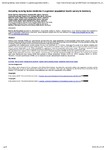Including nursing home residents in a general population health survey in Germany
Gaertner, Beate
Koschollek, Carmen
Grube, Maike M.
Lüdtke, Denise
Fuchs, Judith
Scheidt-Nave, Christa
Gößwald, Antje
Wetzstein, Matthias
Nursing home residents (NHRs) are systematically excluded from the target populations of most population-based health surveys, which may result in biased prevalence estimates. Researchers who wish to include NHRs in surveys face several challenges including difficulty sampling and contacting NHRs and greater levels of functional impairments impeding participation.
A population-wide, register-based, random sample of 8,000 older individuals (57.1% women, mean age=76.2 years) in six primary sampling units (PSUs) in Germany was used to analyse NHR coverage. The contact and response rates among NHRs were compared to those among persons living in private households in two PSUs (N=2,000) by applying an informed sequential mixed-mode design. All persons received a health questionnaire by mail, and random subgroups of initial non-respondents were further contacted by telephone or personal visits.
The population-wide, register-based, random sample included a substantial proportion of NHRs that nearly approximated the national rate of 4.2% NHRs among individuals ≥65 years. Never-theless, undercoverage of a specific subgroup of NHRs was apparent. The contact and re-sponse rates were significantly lower among NHRs than persons in private households (contact: 49.0% vs. 72.9%; response: 20.0% vs. 45.9%). Therefore, it remains questionable if NHRs can be included in regular national health monitoring programmes.
Dateien zu dieser Publikation

